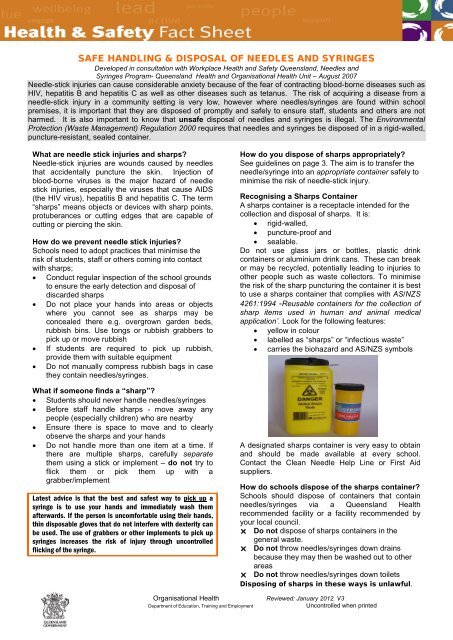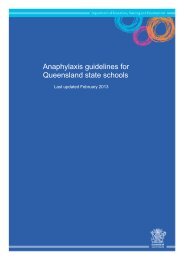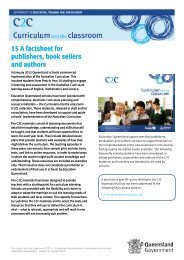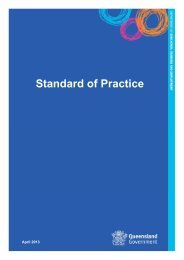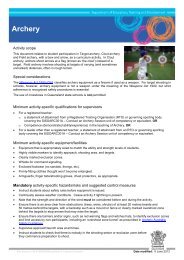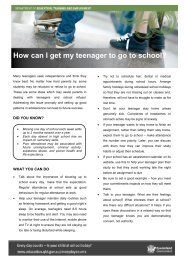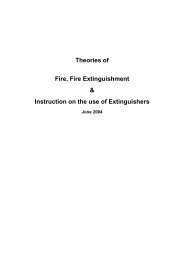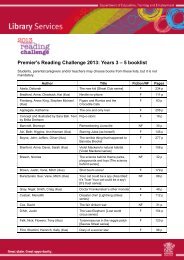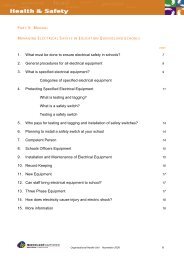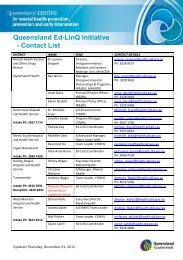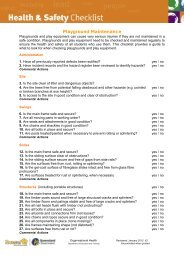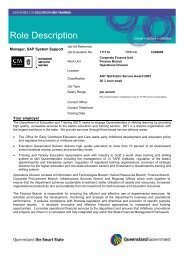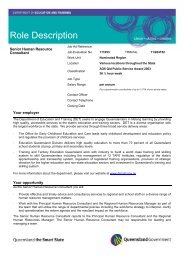Safe Handling and Disposal of Needles and Syringes - Education ...
Safe Handling and Disposal of Needles and Syringes - Education ...
Safe Handling and Disposal of Needles and Syringes - Education ...
You also want an ePaper? Increase the reach of your titles
YUMPU automatically turns print PDFs into web optimized ePapers that Google loves.
SAFE HANDLING & DISPOSAL OF NEEDLES AND SYRINGES<br />
Developed in consultation with Workplace Health <strong>and</strong> <strong>Safe</strong>ty Queensl<strong>and</strong>, <strong>Needles</strong> <strong>and</strong><br />
<strong>Syringes</strong> Program- Queensl<strong>and</strong> Health <strong>and</strong> Organisational Health Unit – August 2007<br />
Needle-stick injuries can cause considerable anxiety because <strong>of</strong> the fear <strong>of</strong> contracting blood-borne diseases such as<br />
HIV, hepatitis B <strong>and</strong> hepatitis C as well as other diseases such as tetanus. The risk <strong>of</strong> acquiring a disease from a<br />
needle-stick injury in a community setting is very low, however where needles/syringes are found within school<br />
premises, it is important that they are disposed <strong>of</strong> promptly <strong>and</strong> safely to ensure staff, students <strong>and</strong> others are not<br />
harmed. It is also important to know that unsafe disposal <strong>of</strong> needles <strong>and</strong> syringes is illegal. The Environmental<br />
Protection (Waste Management) Regulation 2000 requires that needles <strong>and</strong> syringes be disposed <strong>of</strong> in a rigid-walled,<br />
puncture-resistant, sealed container.<br />
What are needle stick injuries <strong>and</strong> sharps?<br />
Needle-stick injuries are wounds caused by needles<br />
that accidentally puncture the skin. Injection <strong>of</strong><br />
blood-borne viruses is the major hazard <strong>of</strong> needle<br />
stick injuries, especially the viruses that cause AIDS<br />
(the HIV virus), hepatitis B <strong>and</strong> hepatitis C. The term<br />
“sharps” means objects or devices with sharp points,<br />
protuberances or cutting edges that are capable <strong>of</strong><br />
cutting or piercing the skin.<br />
How do we prevent needle stick injuries?<br />
Schools need to adopt practices that minimise the<br />
risk <strong>of</strong> students, staff or others coming into contact<br />
with sharps;<br />
• Conduct regular inspection <strong>of</strong> the school grounds<br />
to ensure the early detection <strong>and</strong> disposal <strong>of</strong><br />
discarded sharps<br />
• Do not place your h<strong>and</strong>s into areas or objects<br />
where you cannot see as sharps may be<br />
concealed there e.g. overgrown garden beds,<br />
rubbish bins. Use tongs or rubbish grabbers to<br />
pick up or move rubbish<br />
• If students are required to pick up rubbish,<br />
provide them with suitable equipment<br />
• Do not manually compress rubbish bags in case<br />
they contain needles/syringes.<br />
What if someone finds a “sharp”?<br />
• Students should never h<strong>and</strong>le needles/syringes<br />
• Before staff h<strong>and</strong>le sharps - move away any<br />
people (especially children) who are nearby<br />
• Ensure there is space to move <strong>and</strong> to clearly<br />
observe the sharps <strong>and</strong> your h<strong>and</strong>s<br />
• Do not h<strong>and</strong>le more than one item at a time. If<br />
there are multiple sharps, carefully separate<br />
them using a stick or implement – do not try to<br />
flick them or pick them up with a<br />
grabber/implement<br />
Latest advice is that the best <strong>and</strong> safest way to pick up a<br />
syringe is to use your h<strong>and</strong>s <strong>and</strong> immediately wash them<br />
afterwards. If the person is uncomfortable using their h<strong>and</strong>s,<br />
thin disposable gloves that do not interfere with dexterity can<br />
be used. The use <strong>of</strong> grabbers or other implements to pick up<br />
syringes increases the risk <strong>of</strong> injury through uncontrolled<br />
flicking <strong>of</strong> the syringe.<br />
How do you dispose <strong>of</strong> sharps appropriately?<br />
See guidelines on page 3. The aim is to transfer the<br />
needle/syringe into an appropriate container safely to<br />
minimise the risk <strong>of</strong> needle-stick injury.<br />
Recognising a Sharps Container<br />
A sharps container is a receptacle intended for the<br />
collection <strong>and</strong> disposal <strong>of</strong> sharps. It is:<br />
• rigid-walled,<br />
• puncture-pro<strong>of</strong> <strong>and</strong><br />
• sealable.<br />
Do not use glass jars or bottles, plastic drink<br />
containers or aluminium drink cans. These can break<br />
or may be recycled, potentially leading to injuries to<br />
other people such as waste collectors. To minimise<br />
the risk <strong>of</strong> the sharp puncturing the container it is best<br />
to use a sharps container that complies with AS/NZS<br />
4261:1994 -Reusable containers for the collection <strong>of</strong><br />
sharp items used in human <strong>and</strong> animal medical<br />
application’. Look for the following features:<br />
• yellow in colour<br />
• labelled as “sharps” or “infectious waste”<br />
• carries the biohazard <strong>and</strong> AS/NZS symbols<br />
A designated sharps container is very easy to obtain<br />
<strong>and</strong> should be made available at every school.<br />
Contact the Clean Needle Help Line or First Aid<br />
suppliers.<br />
How do schools dispose <strong>of</strong> the sharps container?<br />
Schools should dispose <strong>of</strong> containers that contain<br />
needles/syringes via a Queensl<strong>and</strong> Health<br />
recommended facility or a facility recommended by<br />
your local council.<br />
� Do not dispose <strong>of</strong> sharps containers in the<br />
general waste.<br />
� Do not throw needles/syringes down drains<br />
because they may then be washed out to other<br />
areas<br />
� Do not throw needles/syringes down toilets<br />
Disposing <strong>of</strong> sharps in these ways is unlawful.<br />
Organisational Health Reviewed: January 2012. V3<br />
Department <strong>of</strong> <strong>Education</strong>, Training <strong>and</strong> Employment Uncontrolled when printed
WHAT SHOULD SCHOOLS DO?<br />
• Establish school-based procedures for dealing with needles <strong>and</strong> syringes found in school grounds based on<br />
the information in this fact sheet.<br />
• Ensure that your school’s procedure regarding rubbish collection by staff, students <strong>and</strong> others follows the<br />
information in this fact sheet e.g.<br />
o provide suitable equipment when picking up rubbish, such as a rubbish grabber tool. This is to eliminate<br />
the risk <strong>of</strong> accidental h<strong>and</strong> to needle/syringe contact as sharps may be concealed under rubbish or<br />
vegetation. The rubbish grabber tool is not to be used to pick up sharps.<br />
o Staff only should h<strong>and</strong>le syringes; if there are multiple needles/syringes, carefully separate them using a<br />
stick or extended implement – do not try to pick them up with a grabber or flick them. <strong>Syringes</strong> should be<br />
picked up using the h<strong>and</strong>s.<br />
• Disseminate the school-based procedures to all in the school community <strong>and</strong> train nominated people such as<br />
the Schools Officer (grounds <strong>and</strong> facilities) in the safe h<strong>and</strong>ling <strong>and</strong> disposal <strong>of</strong> needles/syringes.<br />
School can obtain a pack <strong>of</strong> 20 clean syringes from their local Needle Syringe Program <strong>and</strong> practice picking up <strong>and</strong><br />
separating sharps. This will help identify the method that works best <strong>and</strong> reduce anxiety with touching sharps.<br />
• Educate students regarding how to identify needles/syringes <strong>and</strong> sharps containers <strong>and</strong> what action they<br />
should take if they find these items – for example; 1. do not touch the syringe, 2. one student acts as a spotter<br />
<strong>and</strong> st<strong>and</strong>s near the needle/syringe to warn other students <strong>and</strong> 3. another student immediately reports it to a<br />
staff member<br />
• Inform other school <strong>and</strong> community groups that use your facilities about your procedures<br />
• Ensure you have sharps disposal kits at suitable locations around the school grounds, not just in the<br />
administration building. The kit should include a sharps container, disposable gloves <strong>and</strong> guidelines (next<br />
page).<br />
• The Schools Officer, Cleaning Staff <strong>and</strong> other Staff likely to find needles/syringes should have their own sharps<br />
containers.<br />
• If a needle/syringe is found at your school :<br />
o inform all staff, particularly Schools Officers <strong>and</strong> Cleaners.<br />
o keep a record <strong>of</strong> where <strong>and</strong> when you found the needle/syringe<br />
o ensure procedures are followed including proper disposal<br />
o discuss with staff to determine success or improvements to procedures.<br />
Hepatitis B Vaccination<br />
Vaccination for both Hepatitis A & B is an entitlement for both Schools Officers <strong>and</strong> Cleaners through industrial<br />
agreements. Vaccination costs <strong>and</strong> doctor’s consultation costs are to be funded by the staff member’s school. As a<br />
further precaution, schools should recommend <strong>and</strong> fund hepatitis B vaccinations for other individuals who are at<br />
high risk <strong>of</strong> coming into contact with needles or syringes.(e.g. cleaning, building <strong>and</strong> grounds maintenance roles).<br />
Immunisation records should be kept for each worker. Workers who are at significant risk <strong>of</strong> contact with used<br />
needles <strong>and</strong> syringes should have a blood test 4 weeks after completing the course <strong>of</strong> vaccination to ensure that<br />
they have developed adequate immunity.<br />
For more information<br />
Creating Healthier Workplaces Website - Hepatitis A&B Fact Sheet, Infection Control Guidelines<br />
http://education.qld.gov.au/health/safety/hazards/infection.html<br />
Queensl<strong>and</strong> Health Website – <strong>Safe</strong> <strong>Disposal</strong> <strong>of</strong> <strong>Needles</strong> <strong>and</strong> <strong>Syringes</strong><br />
http://www.health.qld.gov.au/goodhealthintnq/topics/needles.asp<br />
Queensl<strong>and</strong> Health – Clean Needle Helpline - phone: 1800 633 353<br />
Organisational Health Reviewed: January 2012. V3<br />
Department <strong>of</strong> <strong>Education</strong>, Training <strong>and</strong> Employment Uncontrolled when printed
Guidelines for the disposal <strong>of</strong> needle/syringe into a sharps container<br />
Equipment : thin, disposable latex, vinyl or nitrile gloves<br />
sharps container<br />
Procedure Precautions<br />
Step 1 Put on disposable latex or vinyl<br />
gloves (if available). Gloves will not<br />
prevent the wearer from being injured but<br />
will form a clean barrier between the h<strong>and</strong>s<br />
<strong>and</strong> the syringe.<br />
Step 2 Bring your rigid-walled, punctureresistant,<br />
sealable, sharps container to the<br />
syringe.<br />
Step 3 Place the container on the ground<br />
or flat surface beside the syringe.<br />
Step 4 Pick up the syringe by the middle<br />
<strong>of</strong> the barrel<br />
Note Do not use a dustpan & brush to<br />
“sweep up” the syringe as the sweeping<br />
movement can cause the syringe to flick<br />
into the air <strong>and</strong> cause further risk.<br />
Step 5 Place the syringe in the container<br />
sharp end first.<br />
Step 6 Securely place the lid on the<br />
container <strong>and</strong> ensure it is sealed. Hold the<br />
container by the top when carrying.<br />
Step 7 Remove gloves carefully so any<br />
contaminated fluid on the glove does not<br />
come into contact with your h<strong>and</strong>.<br />
Wash your h<strong>and</strong>s with running water <strong>and</strong><br />
soap.<br />
Do not attempt to recap the needle – this is how most accidental<br />
needle-stick injuries happen. The cap is usually bright orange<br />
<strong>and</strong> can be disposed <strong>of</strong> separately. Do not break, bend or<br />
otherwise try to render the syringe useless.<br />
Take the sharps container to the syringe, do not walk with the<br />
needle/syringe.<br />
Do not hold the sharps container or ask another person to hold it<br />
as you are disposing <strong>of</strong> the syringe.<br />
The safest method <strong>of</strong> picking up a syringe is by h<strong>and</strong>. Staff can<br />
also chose to wear thin, disposable gloves that do not hinder<br />
dexterity. Do not crack the plastic barrel <strong>of</strong> the syringe or flick the<br />
syringe.<br />
Plastic tweezers are not recommended as they may also cause<br />
the needle/syringe to flick (commonly bright coloured <strong>and</strong> found<br />
in many ‘sharps disposal kits” sold at pharmacies etc).<br />
Keep the sharp end <strong>of</strong> the needle facing away from you at all<br />
times.<br />
Place the sealed container into your sharps disposal bin or<br />
contact your local council or health department regarding safe<br />
ways to dispose <strong>of</strong> your sharps container.<br />
Other items that have come into contact with blood (i.e. gloves)<br />
should be disposed <strong>of</strong> in the same container as the used syringe<br />
or placed into double plastic bags <strong>and</strong> then into the rubbish.<br />
What to do if a needle stick injury occurs<br />
• Stay calm.<br />
• Encourage the wound to bleed (gently squeeze).<br />
• As soon as possible wash the area with running water <strong>and</strong> soap (if available).<br />
• Apply an antiseptic <strong>and</strong> b<strong>and</strong>-aid.<br />
• As soon as possible contact your supervisor.<br />
• It is important to be medically assessed as soon as possible. Visit your local doctor or<br />
hospital emergency department promptly; they will manage blood testing, counselling<br />
<strong>and</strong> possible hepatitis B <strong>and</strong> tetanus vaccination <strong>and</strong>/or medication.<br />
• Staff can access the Employee Assistance Service (EAS) for free confidential counselling<br />
or seek the assistance <strong>of</strong> another counselling service.<br />
• Dispose <strong>of</strong> the needle/syringe safely. Testing <strong>of</strong> syringes is usually not conducted so there<br />
is no need to keep the syringe.<br />
Keep a copy <strong>of</strong> this page with each sharps kit in your school.<br />
This guideline should also be displayed in relevant areas within your school<br />
e.g. first aid room, Schools Officer’s room, Cleaner’s storeroom etc.<br />
Organisational Health Reviewed: January 2012. V3<br />
Department <strong>of</strong> <strong>Education</strong>, Training <strong>and</strong> Employment Uncontrolled when printed


